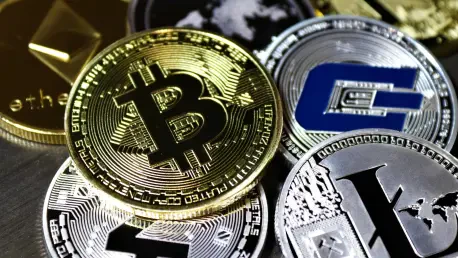The financial realm in the United States stands on the brink of a monumental transformation as the Federal Reserve unveils sweeping updates to its payment infrastructure, introducing instant settlements for the first time in nearly half a century. This ambitious modernization effort, driven by platforms like the FedNow Service, seeks to overhaul the way funds flow between banks, businesses, and everyday consumers with remarkable speed and efficiency. For holders of XRP, a digital asset built on the XRP Ledger and renowned for its rapid, low-cost transactions, this shift is nothing short of pivotal. It prompts pressing questions about the role blockchain technologies will play when traditional financial systems begin to mirror the agility once exclusive to cryptocurrencies. As the lines between centralized and decentralized solutions blur, the implications for XRP are both complex and far-reaching, setting the stage for a redefined payments landscape where adaptation and collaboration may determine long-term relevance.
Revolutionizing U.S. Payments with FedNow
The Federal Reserve, under Chair Jerome Powell’s guidance, is addressing decades-old inefficiencies in domestic payment systems through the FedNow Service, which became operational in July 2023. This groundbreaking platform allows financial institutions to execute transactions instantly, around the clock, representing the most significant update to U.S. payment rails since the 1970s. By 2024, over 500 banks had integrated this service, showcasing its potential to transform everyday finance. The advantages are evident: individuals gain immediate access to wages, while businesses can settle invoices without the typical delays. Powell has emphasized the urgency of this upgrade, noting that it aligns with modern economic demands for speed. Yet, he also cautions that achieving universal adoption across the diverse banking sector remains a long-term endeavor, highlighting the gradual nature of this systemic change and the challenges of scaling such an initiative nationwide.
Beyond the immediate benefits, the FedNow rollout signals a broader commitment to aligning U.S. financial infrastructure with global benchmarks for real-time payments. This initiative is not merely a technological upgrade but a response to growing consumer and business expectations for seamless, instantaneous transactions. While the service focuses on domestic transfers, its success could influence how financial institutions perceive the need for alternative solutions in other areas. The phased adoption also means that gaps in coverage or functionality may persist for years, creating a window where complementary technologies could address unmet needs. For stakeholders, the Fed’s determination to modernize reflects a recognition that delays in payment processing are no longer acceptable in a digital economy, setting a new standard that all financial tools—traditional or innovative—must meet to remain competitive in an increasingly fast-paced market.
XRP’s Position Amidst Financial Evolution
For those invested in XRP, the Federal Reserve’s push for instant payments through FedNow introduces a nuanced mix of challenges and possibilities. If FedNow effectively fulfills the demand for rapid domestic transactions, financial institutions might see less urgency in adopting blockchain-based alternatives like XRP for local needs. The centralized nature of FedNow, backed by governmental authority, offers a level of trust and accessibility that could overshadow decentralized solutions in certain contexts. This development might limit XRP’s immediate appeal within the U.S. market, where the focus is on streamlining internal payment processes. However, this shift does not necessarily spell obsolescence for XRP, as its unique features could still hold significant value in scenarios where centralized systems are less effective, prompting a reevaluation of its strategic positioning.
Conversely, the modernization of traditional rails could open new avenues for XRP to shine, particularly in areas beyond FedNow’s current scope, such as cross-border transactions. The XRP Ledger’s ability to facilitate swift, cost-effective transfers with on-demand liquidity remains a distinct advantage for international payments, where centralized systems often struggle with complexity and expense. Experts argue that financial institutions might still turn to blockchain solutions to address gaps like after-hours liquidity or currency conversion challenges. This suggests a potential for coexistence, where XRP complements rather than competes with emerging domestic systems. For holders, this duality underscores the importance of monitoring how XRP adapts to a landscape where traditional finance is rapidly evolving, potentially carving out a niche in global markets even as domestic solutions gain traction.
Bridging Centralized and Decentralized Futures
A striking trend accompanying U.S. payment modernization is the growing convergence between centralized systems like FedNow and decentralized frameworks such as blockchain networks. As the U.S. catches up to real-time payment standards already prevalent in regions like Europe and Asia, the financial ecosystem appears poised for a hybrid model that integrates the strengths of both approaches. For the XRP community, this shift implies that long-term success may depend less on direct rivalry with traditional systems and more on strategic partnerships or interoperability. The ability of XRP to address specific pain points—such as tokenized liquidity for international markets—could position it as a vital component in a broader, interconnected payments framework that blends the reliability of centralized infrastructure with the innovation of decentralized technology.
This convergence also reflects a global momentum toward instant financial transactions, pushing all players in the sector to elevate their offerings. While FedNow focuses on domestic efficiency, its influence could raise expectations for speed and accessibility across all forms of payment, including those facilitated by blockchain. For XRP, this heightened standard presents an opportunity to demonstrate its value in specialized use cases that centralized systems might not fully address. The evolving landscape suggests that integration could be the key to relevance, with hybrid solutions potentially offering the best of both worlds—security and scale from traditional rails, paired with the agility and reach of blockchain. Stakeholders in XRP must consider how to navigate this blending of systems, advocating for compatibility that ensures the digital asset remains a practical tool in an increasingly unified financial environment.
Voices from the XRP Community and Beyond
Reactions within the XRP community to the Federal Reserve’s modernization efforts reveal a blend of optimism and cautious analysis, often amplified by thought leaders like crypto analyst Levi Rietveld on social platforms. Many enthusiasts interpret the Fed’s focus on instant settlements as an endorsement of the real-time payment paradigm that XRP has long exemplified through the XRP Ledger. Discussions sparked by Rietveld’s insights into Powell’s remarks suggest that the broader push for efficiency in finance could elevate the visibility of blockchain solutions, even if indirectly. This perspective holds that as traditional systems adopt faster processes, the foundational principles of speed and accessibility championed by XRP gain validation, potentially strengthening its case as a forward-thinking financial tool in the eyes of both users and institutions.
At the same time, there exists a pragmatic recognition of the competitive dynamics introduced by a robust, government-supported system like FedNow. Community discourse acknowledges that the Fed’s emphasis on creating fast, secure, and widely accessible payment options for all financial entities poses a challenge to blockchain alternatives in domestic settings. The centralized model’s ability to ensure equal access across varied institutions contrasts with the decentralized ethos of XRP, creating a tension that must be navigated carefully. Despite this, the dialogue remains forward-looking, with many in the community focusing on how XRP can differentiate itself by addressing international or niche needs. This balanced view reflects a maturity in understanding that while competition exists, the overarching trend toward modernization could ultimately create space for diverse solutions to coexist and thrive.
Shaping the Path Forward for XRP Holders
Reflecting on the transformative journey of U.S. payment systems, the rollout of FedNow since its inception in 2023 stands as a landmark achievement, with over 500 banks embracing the platform by 2024 to enable instant transactions. This historic push redefined financial interactions for countless Americans, setting a precedent for speed and accessibility. For the XRP community, the implications are multifaceted, balancing the risk of reduced domestic relevance against the promise of synergies in global contexts. The narrative of convergence between centralized and decentralized systems emerged as a guiding theme, hinting at a future where collaboration trumps rivalry.
Looking ahead, XRP holders should focus on advocating for integration with evolving traditional infrastructures, ensuring the digital asset remains adaptable to hybrid financial models. Exploring partnerships with financial institutions for cross-border solutions could solidify XRP’s utility. Additionally, staying attuned to global payment trends will be crucial, as opportunities may arise in markets where instant, low-cost transactions are still unmet needs. As the financial sector continues to evolve, proactive engagement with these developments will help position XRP as a complementary force in shaping the next era of payments.









